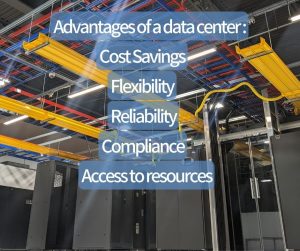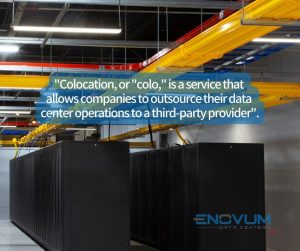Data centre migration is a complex task, and it requires careful planning and execution to ensure a successful transition. It’s important to have a checklist of key steps and best practices to ensure that the process is as smooth as possible. This article provides a comprehensive checklist to streamline your data centre migration.
What is Data Center Migration?
Data Center Migration, a data center move transfers data and applications from one physical location to another. The process is often used to move data from a data center or a facility that is no longer adequate for the organization’s needs. Organizations can use new technologies, increase space, and improve reliability by moving to a new location.
A Data Center Migration can be done either through a physical move, where the data and applications are physically transported to the new location or through a virtual move, where the data and applications are transferred over the internet.
The colocation process may also involve transferring data and applications from one server to another. This can be done through a physical transfer, where the data and applications are transferred directly between servers, or through a virtual transfer, where the data and applications are transferred over the internet.
In addition to data and applications, colocation can also involve transferring physical assets such as server racks and other hardware. This can be a complicated process, as the hardware must be carefully packaged and transported to the new location.
Benefits of a Migration to a Data Center
Colocation offers numerous benefits to organizations. For example, organizations can take advantage of new technologies, increased space, and improved reliability by moving to a new location.
One of the key benefits of colocation is increased flexibility. By moving to a new location in a data center, organizations can take advantage of new technologies and increased space, which can help them to scale their operations more quickly and efficiently.
Another benefit of colocation is improved reliability. By moving to a new location, organizations can take advantage of improved infrastructure, which can help to reduce downtime and ensure that systems are running at peak performance.
Colocation also offers improved security. By moving to a new location, organizations can take advantage of enhanced security measures, such as physical security and data encryption. This can help to protect data and minimize the risk of data breaches.
Finally, colocation can also help organizations to reduce costs. By moving to a new location, organizations can take advantage of lower costs for electricity, cooling, and other resources. This can reduce the overall cost of running the data center.
Types of Colocation Services
When planning a data center move, organizations must consider the different colocation services available. The most common types of colocation services are on-site, off-site, and hybrid.
On-site colocation is when an organization hosts its data center physically. This can benefit organizations that need to maintain control over their data center, but it can also be more expensive and complex.
Off-site colocation is when an organization outsources its data center to a third-party provider. Finally, hybrid colocation is when an organization hosts its own data center in a physical location and uses off-site colocation services to supplement its on-site services. This can benefit organizations that need to take advantage of the benefits of both on-site and off-site colocation, but it can also be more complex to manage.
Colocation vs. Traditional Data Centers
Organizations must consider the differences between traditional data centers and colocation when considering a data center move. Traditional data centers typically require organizations to manage their hardware, software, and infrastructure. This can be beneficial for organizations that need to maintain control over their data center, but it can also be more expensive and complex.
In contrast, colocation services typically provide organizations access to pre-configured servers, storage solutions, and managed infrastructure and support services.-
Colocation Pricing Models
Organizations must consider the different pricing models available when selecting a colocation provider. The most common colocation pricing models are pay-as-you-go, flat-rate, and managed services.
Pay-as-you-go colocation is when organizations pay for the resources they use. This can benefit organizations that need to scale their operations quickly and efficiently, as they only pay for the necessary resources.
Flat-rate colocation is when organizations pay a fixed rate for a set amount of resources. This can benefit organizations that need to reduce costs, as they know exactly how much they will pay for their data center services.
Finally, managed services colocation is when organizations pay for managed services from a third-party provider. This can benefit organizations that need to reduce complexity, as the third-party provider will manage the data center for them.
How to Choose the Right Colocation Provider
When selecting a colocation provider, organizations must consider several factors. Reliability, scalability, security, compliance, and cost are the most critical factors.
Reliability is one of the most critical factors when selecting a colocation provider. Organizations need to ensure that the provider can provide reliable and secure services.
Scalability is also an essential factor to consider. Organizations must ensure that providers can scale their data center services as their operations grow.
Security is another important factor to consider. Organizations must ensure the provider can provide robust security measures to protect their data and applications.
Compliance is also an important factor to consider. Organizations need to ensure that the provider can meet the relevant regulatory requirements.
Finally, the cost is also an important factor to consider. Organizations must ensure that the provider can provide competitive service pricing.
Hybrid Colocation Solutions
Organizations must consider the different hybrid colocation solutions available when considering a data center move. Hybrid colocation solutions are a combination of on-site and off-site colocation solutions. These solutions can benefit organizations that need to take advantage of the benefits of both on-site and off-site colocation. Still, they can also be more complex to manage.
The most common hybrid colocation solutions are dedicated and shared hybrid colocation. Dedicated hybrid colocation is when an organization hosts its own data center in a physical location but also uses off-site colocation services to supplement its on-site services. Shared hybrid colocation is when an organization shares its data center with other organizations but also uses off-site colocation services to supplement its on-site services.
Colocation Security and Compliance
When selecting a colocation provider, organizations need to make sure that the provider is able to meet the relevant security and compliance requirements. The most important security requirements to consider when selecting a colocation provider are physical security, data security, and network security.
Physical security is one of the most important security requirements to consider when selecting a colocation provider. Organizations need to ensure that the provider can provide adequate physical security measures, such as access control, video surveillance, and fire detection systems.
Data security is also an important security requirement to consider. Organizations need to ensure that the provider can provide robust data security measures, such as encryption, access control, and data backup.
Finally, network security is also an important security requirement to consider. Organizations need to ensure that the provider can provide robust network security measures, such as firewalls, intrusion detection systems, and secure communication protocols.
Organizations also need to ensure that the provider can meet the relevant compliance requirements. The most important compliance requirements to consider when selecting a colocation provider are data privacy laws and industry standards. Organizations need to ensure that the provider can meet the relevant data privacy laws. Organizations also need to ensure that the provider can meet the relevant industry standards.
Conclusion
Data centre migration is a complex task that requires careful planning and execution to ensure a successful transition. This article provided a comprehensive checklist to streamline your data centre migration.
The most important steps to consider when planning a data centre migration are selecting the right colocation provider, understanding the different types of colocation services, understanding the different colocation pricing models, understanding the differences between traditional data centers and colocation, understanding the different hybrid colocation solutions, understanding colocation security and compliance, and understanding colocation and edge computing.
If you need help with your data centre migration, contact enovumdc.com. Our experts can help you to streamline your data centre migration with our comprehensive checklist.






